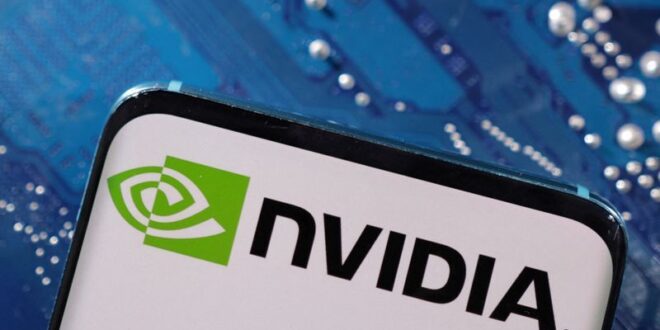NEW YORK (Reuters) – No single stock has embodied the U.S. market’s artificial intelligence fervor as much as Nvidia Corp, leaving Wall Street tied to the fluctuations of its volatile shares.
The semiconductor company, whose chips are considered the gold standard in the AI industry, forecast fiscal first-quarter revenue above estimates after the market closed on Wednesday in one of the most highly anticipated earnings releases in recent memory.
Given the company’s status as a bellwether of the AI industry and its heavy weighting in U.S. indexes, the way investors react to its earnings report in coming days could offer a glimpse of whether risk appetite continues to thrive in a stock market that has cruised to record highs despite climbing Treasury yields and fading hopes that the Federal Reserve will begin cutting rates in coming months.
“The response to the numbers could be seen as a referendum on the market itself,” said Paul Marino, chief revenue officer at GraniteShares, which manages exchange traded funds tied to Nvidia’s performance. “If Nvidia beats expectations and the stock still falls, that will tell us that people are anxious.”
Nvidia shares tripled in 2023 and are up nearly 40% this year on growing excitement over the business potential of artificial intelligence. That’s made it a standout performer among the so-called Magnificent Seven group of growth and technology stocks that have been the market’s key drivers over the past year.
Nvidia eclipsed the $1 trillion mark for market capitalization in the middle of last year. Earlier this month, it passed Amazon and Alphabet to become the third-largest U.S. company by market value, although its recent pullback put the company back in fifth.
The company’s heftier market value has given it significant sway in key indexes, including the S&P 500. As of Tuesday’s close, Nvidia’s soaring shares have accounted for more than a quarter of the 4% gain in the index, which hit a record high earlier this month.
Nvidia’s rise comes as the company has put up big increases in revenue and profit amid an artificial intelligence boom that has fueled demand for its chips. Revenue more than doubled to over $60 billion in its latest fiscal year, while net income soared to nearly $30 billion.
Rapid increases in analysts’ earnings estimates means its forward earnings valuation has fallen even as its share price has exploded higher.
The company traded at 31 times forward earnings ahead of Wednesday’s report, compared to 47 times earnings a year ago, LSEG data showed.
Nvidia options late Wednesday were pricing a swing of about 10% in either direction in the two trading days following its results, according to data from options analytics service Trade Alert. A 10% move in Nvidia’s nearly $1.7 trillion in market value would be roughly equivalent to the current market cap of Qualcomm or Comcast.
Nvidia’s shares soared 14% and 24% in the day following its quarterly reports in February and May last year, but the stock’s reaction has been more tepid in recent quarters.
Options wagers on where Nvidia shares could go in the next few days ran the gamut, with some traders targeting a drop below $500 by the end of this week while others are betting on a move to $1,300 by Friday, a near double. Nvidia’s shares closed at $674.72 on Wednesday.
While Nvidia has been the poster child for AI, it has not been the only stock to benefit from excitement over the technology. Shares of companies such as Super Micro Computer and Arm Holdings have jumped in recent weeks, although both stocks have pulled back recently.
Even beyond the semiconductor and technology fields, companies across industries have playing up their exposure to AI. Artificial intelligence has been mentioned on 38% of S&P 500 quarterly conference calls in January and February, a slightly higher percentage than during the June quarter, when AI took hold as a prominent industry and market theme.
(Reporting by Lewis Krauskopf and Noel Randewich; additional reporting by Suzanne McGee and Saqib Iqbal Ahmed; Editing by Ira Iosebashvili and Stephen Coates)
 BeritaKini.biz Berita Viral Terkini di Malaysia
BeritaKini.biz Berita Viral Terkini di Malaysia





